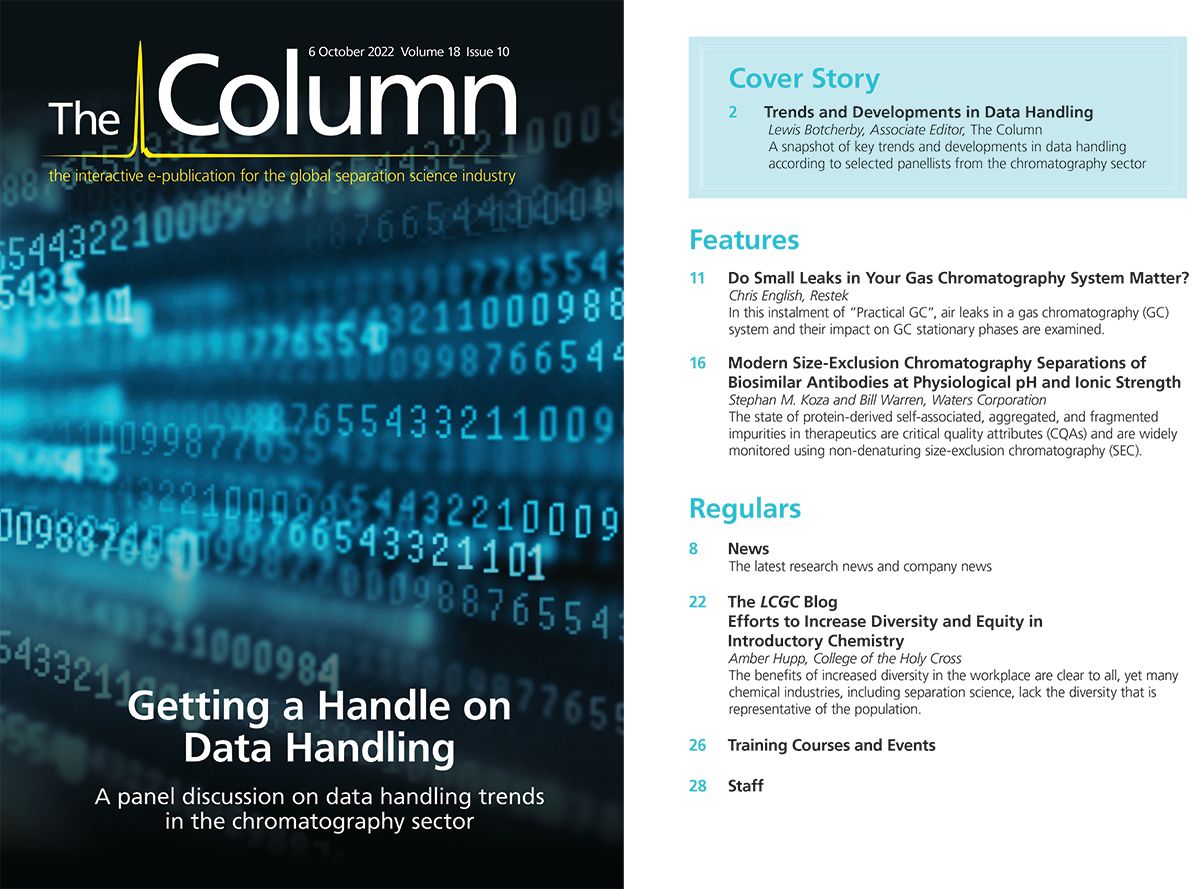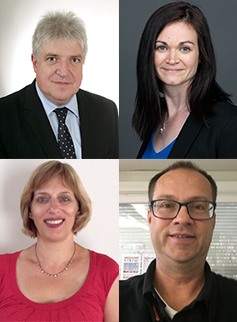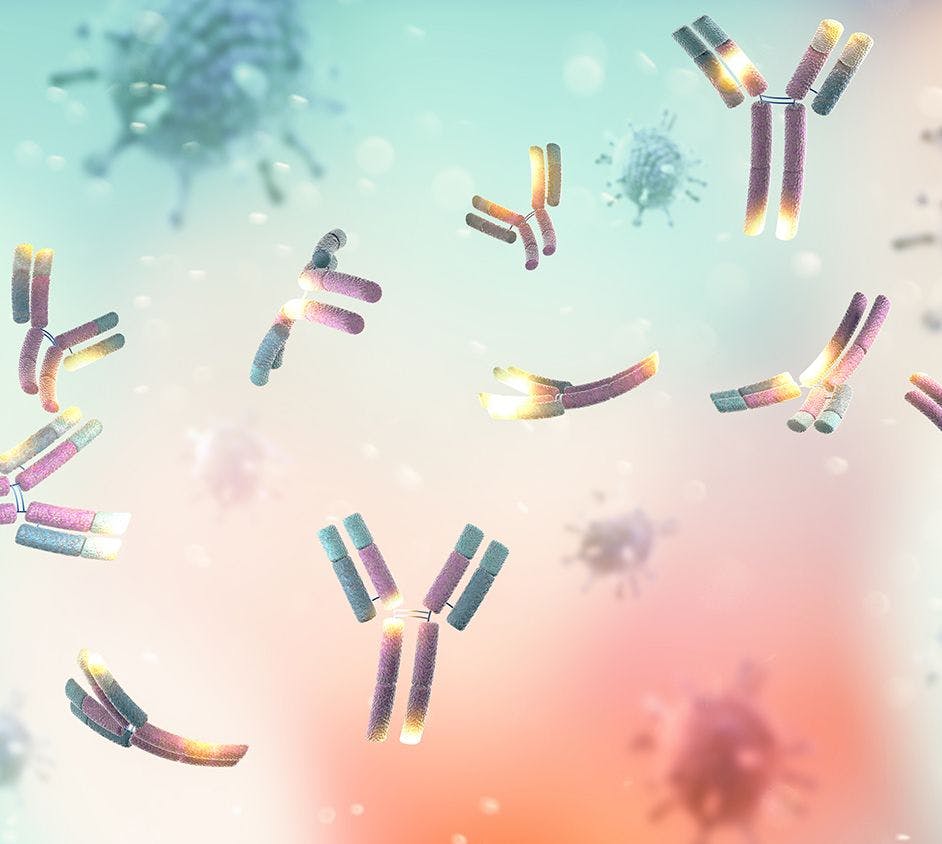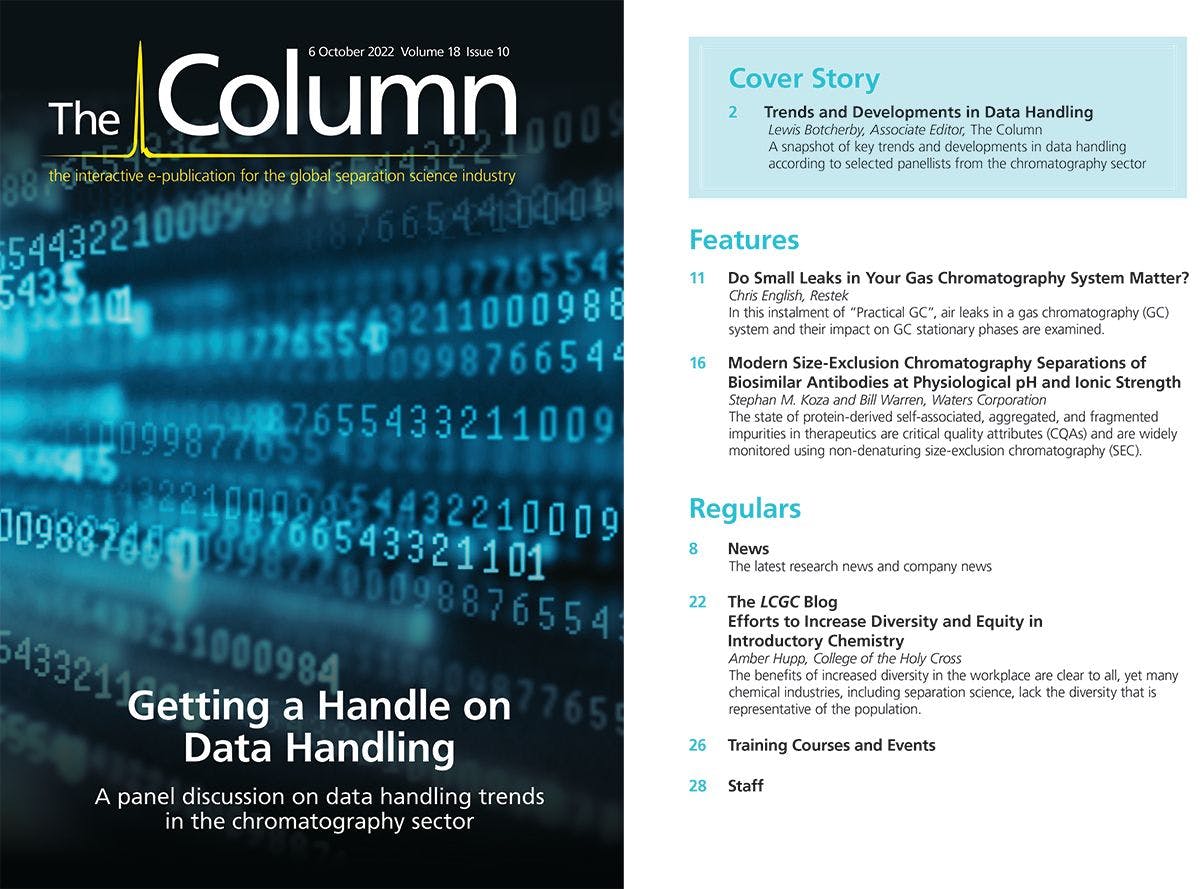Features: Efforts to Increase Diversity and Equity in Introductory Chemistry
Increased diversity in the workplace brings broader perspectives and innovation. Yet many chemical industries, including separation science, lack the diversity that is representative of the population. To fix this problem, we must start at the beginning of the pipeline.
Understanding the Lack of Diversity in STEM
I recently read a paper in the Journal of Chemical Education that cited some statistics regarding diversity among chemists. White et al. reported that “only 6.2% of chemists and materials scientists, chemical engineers, and chemical technicians identified as Black or African American, and only 7.0% identified as Hispanic or Latinx, percentages that are far lower than in their total U.S. populations” (1). The data are not broken down by sub-discipline, but I would imagine the representation in the separations community is quite similar.
I have been reading about diversity, equity, and inclusion (DEI) in introductory science, technology, engineering, and mathematics (STEM) courses for several years now. So, I guess these numbers shouldn’t have been quite as shocking to me as they were. I know that racially minoritized students express interest in STEM at the same rate as their white peers, yet do not persist at the same rate through STEM courses and majors. In fact, national trends show that only 14.7% of STEM bachelor’s degrees are awarded to minoritized students (1). At many institutions, the DFW rate (the percentage of students that earn a D or F grade or withdraw from a course) in introductory STEM courses is higher for minoritized students than it is for white or Asian populations. First generation students are also more likely to feel excluded and struggle in introductory courses.
The problem has long been thought to be the students. That is, that students who have a stronger background or are highly motivated to learn can be successful, while students with weaker backgrounds may not be able to rise to the rigour of STEM courses. As Wilson-Kennedy et al. stated clearly in their 2020 article, “We need to move beyond traditional arguments of merit and preparedness to start to question how these individuals experience our institutions in the classroom, the research laboratory, and the scientific culture” (2). They argue, like many other experts in DEI practices, that we must investigate the role of bias, marginalization, systematic racism, and microaggressions in order to create an inclusive and welcoming environment in our classrooms and laboratories (2). The problem is not our students. The problem is how are students are experiencing our classrooms. Equitable and inclusive foundational courses are needed for all students, regardless of preparation and background, to thrive and learn. This paper, along with David Asai’s informative manuscript titled “Race Matters”, are valuable resources for scientists wanting to learn more about structural inequities in STEM education (2,3).
Thankfully, folks in higher education are paying attention. I know from attending ACS workshops geared towards department chairs that many institutions are evaluating the inclusivity of their introductory sequences. Workshops and conferences devoted to discussion of diversity, equity, inclusion, and racism in science are now easy to find. Many institutions have DEI offices. Some institutions, like mine, have Deans of Faculty who are gently pushing faculty to evaluate their instructor mindset, their classroom ecology, and their curricular practices. Most academic chemists have little formal training in education. We learn by our own practice, by reading the literature, and through discussion of best practices with other educators. It is now time for us to take on the important work of increasing the diversity of our field by making our classrooms more inclusive and equitable.
So You’re Not an Academic…
I know many readers here are not academics. If you’ve made it this far in this blog, you might be thinking that there is no way for you to contribute to the start of the pipeline. I would argue that industrial and government chemists play very important roles in our academic world. Our students aspire to be you one day. They love to know what types of scientists exist, what kind of work you are doing, what courses they should take to get where you are. If you are reading this, especially if you belong to a group of people who are underrepresented in chemistry, I encourage you to reach out to a chemistry department at a local college or university and offer to speak with students. That old saying that representation matters is real (4). When students see someone who looks like them, with a background like them, who struggled like them, but who made it to where they want to be, that’s huge for their confidence and their drive. I would love to see more students inspired at an early age to become separation scientists. I hope you will consider my plea to engage with this young generation of budding chemists.
Examples of Inclusive Practices
So here’s the thing. Knowing the problem exists and creating a solution to it are entirely different. There is no magic wand that can be waved to completely fix the issues of systematic injustice overnight. There are, however, many reports of small-to-medium-scale changes that can begin to address equity issues in the classroom. My goal is to provide a few of the strategies that I’ve read about this year—the ones I am most excited to share and try to implement in my own courses. A quick disclaimer: I am not an expert in this area, and this list is not exhaustive by any means. For those of you in academia, perhaps some of these strategies will be new to you and you could consider their effect in your classroom. For those in industry or government sectors, I hope you glean some insight into the changing landscape of academia and how students may be trained in undergraduate courses in the years
to come.
Many inclusive pedagogies rely on the idea that students must develop a positive growth mindset (the idea that intelligence is malleable rather than fixed) for themselves. Maries et al. “note that providing a growth mindset also helps with students’ self-efficacy, because it helps students recognize that anybody could be good at [science], it just takes engaging in effective practice, working with others, and getting immediate feedback” (5). Scientists and mathematicians have developed a variety of practices that could be implemented to increase equity and performance for students regardless of their preparedness upon starting the course (6).
I have written previously about the vast body of active learning work being done by the analytical community (7). Active learning has been shown to increase exam performance while reducing persistent achievement gaps in STEM. A variety of active learning pedagogies exist and can be customized to different classroom styles and sizes. I have used active learning in instrumental chemistry courses and in general chemistry and find their use to be engaging and dynamic.
The use of low-stakes assignments has been evaluated in different ways. Eddy and Hogan assessed the value of increased course structure, comparing low and moderate course structures, using guided‑reading questions, preparatory homework, and in-class activities (8). Students have more opportunities to make mistakes that are not costly to their grade, and receive formative feedback before an official assessment like an exam. Eddy and Hogan found that in the moderate course structure group, all students exhibited increased exam performance by 3.2%, yet larger gains were observed for black students (an additional 3.1%) and first‑generation students (an additional 2.5%) (8). This is an important note. Not only did students of colour and first generation students perform better but all students also performed better on the high-stakes assessment.
Mindset interventions regarding stereotypes have been employed in introductory physics and biology classrooms. An article by Binning et al. describes the use of an ecological‑belonging intervention meant to normalize social and academic adversity (9). The intervention occurs at the beginning of the semester to establish a growth mindset in each student early on. Students learn that it is okay to struggle and that, while the course is challenging, they too can do hard work and be successful in the class, regardless of their incoming preparation. Interestingly, the intervention was most impactful on historically underperforming students in each field, that is, minorities in introductory biology, and women in introductory physics.
Mastery grading attempts to address issues related to information retention, where students can earn enough partial credit to earn a “good grade” yet not have fully mastered a single topic (10). A list of objectives are created that are evaluated over the course of the semester. Students have multiple attempts over the semester to master each objective. This type of intervention supports a growth mindset allowing students to achieve based on continued revision instead of assigning a grade based on a first assessment. The use of mastery grading has been explored more fully in the field of mathematics where some topics are not as hierarchical. Members of my own department are experimenting with the idea of using mastery grading for some topics in our first semester general chemistry course.
White et al. claim that a combination of evidence-based inclusive practices (including fostering a sense of belonging, validating students scientific identities, allowing students to make mistakes, being an intrusive instructor, cultivating relationships, and employing active learning and group work) can reduce the equity gap in introductory courses (1). Regular interventions, such as framing the challenges students may face on an exam, presenting a “Chemist of the Week” drawing from a diverse pool of chemists, and encouraging reflection of their exam performance using an “exam wrapper” exercise, were employed to increase equity in the classroom.
Muniz et al. share their efforts to transform an introductory chemistry course using a combination of cognitive and affective strategies (11). For example, students find the support of a highly structured course (cognitive), along with interleaving of course topics (cognitive), and affirmation-based mindset interventions (affective) to be transformative in their learning. The authors provide concrete examples and a detailed schedule of the cadence of both affirmative interventions and cognitive assignments.
A Final Thought
Change in academia is slow and can be quite hard at times. This work is no different. Increasing inclusivity and equity in chemistry will require a positive instructor mindset, one of growth of the discipline. It will require invention and trials. It will involve exploration. I have begun to think about this work as a summative process, that with each paper read, each intervention implemented, and each student that achieves their goals, we are inching our way to a more diverse group of chemists, analytical chemists, separation scientists. And while that work may be slow and the road long, the end goal is too important to not try.
References
- K.N. White, K. Vincent-Layton, and B. Villarreal, J. Chem. Educ. 98, 330–339 (2021).
- Z.S. Wilson-Kennedy, F. Paton-Steward, and L.L. Winfield, J. Chem. Educ. 97, 2041–2044 (2020).
- D.J. Asai, Cell 181, 754–757 (2020).
- K.L. Yabut Nadal, Psychol. Today posted 27.12.2021, accessed 10.8.2022. https://www.psychologytoday.com/us/blog/psychology-the-people/202112/why-representation-matters-and-why-it-s-still-not-enough
- A. Maries, N.I. Karim, and C. Singh, Phys. teach. 58, 430–433 (2020).
- K.D. Tanner, CBE-Life Sci. Educ. 12, 322–331 (2013).
- A.M. Hupp. The LCGC Blog, posted 11.8.2020, accessed 10.8.2022. https://www.chromatographyonline.com/view/chromatography-resources-for-online-learning
- S.L. Eddy and K.A. Hogan, CBE-Life Sci. Educ. 13, 453–468 (2014).
- K.R. Binning et al., Psychol. Sci. 31,
1059–1070 (2020). - R. Campbell, D. Clark, and J. O’Shaughnessy, PRIMUS 30, 837–848 (2020).
- M.N. Muniz, C. Altinis-Kiraz, and M.E. Emenike, J. Chem. Educ. 99, 227–238 (2022).
This blog is a collaboration between LCGC and the American Chemical Society Analytical Division Subdivision on Chromatography and Separations Chemistry (ACS AD SCSC).
Amber Hupp is Associate Professor of Chemistry at the College of the Holy Cross in Worcester, Massachusetts, USA. She earned her B.A. from Kalamazoo College and her Ph.D. in chemistry from Michigan State University, under the guidance of Professor Victoria McGuffin. Amber enjoys teaching a wide range of courses including environmental chemistry, general chemistry, and instrumental analysis. Her research group utilizes gas chromatography and a range of chemometric methods to understand the fatty acid methyl ester content in biodiesel produced from different feedstocks as well as in biodiesel diesel blended fuels. She has served as an executive board member of the ACS Subdivision on Chromatography and Separations Chemistry (SCSC) for several years and is the current chair.

A Matrix-Matched Semiquantification Method for PFAS in AFFF-Contaminated Soil
Published: April 14th 2025 | Updated: April 14th 2025Catharina Capitain and Melanie Schüßler from the Faculty of Geosciences at the University of Tübingen, Tübingen, Germany describe a novel approach using matrix-matched semiquantification to investigate per- and polyfluoroalkyl substances (PFAS) in contaminated soil.
Silvia Radenkovic on Building Connections in the Scientific Community
April 11th 2025In the second part of our conversation with Silvia Radenkovic, she shares insights into her involvement in scientific organizations and offers advice for young scientists looking to engage more in scientific organizations.















